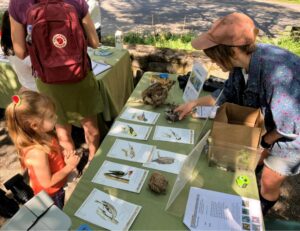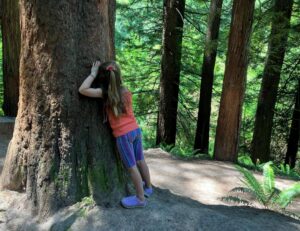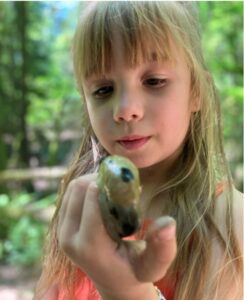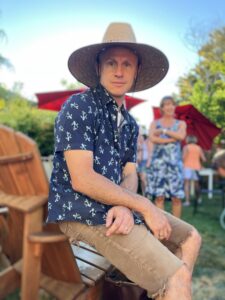My daughter Vivian’s summer camp canceled their entire week of programming on the first day of camp.
Summer Scramble
Vivian had just graduated kindergarten, and even if she wasn’t super excited about getting carsick in the camp’s big school bus, she was excited that it was finally summer. Then she found herself stuck in the indoor adult world of work deadlines and Zoom meetings.
My wife and I scrambled to assemble activities for her, so Vivian spent the week having play dates. She watched cartoons like Creature Cases that featured animal. And she ran around our yard and made crafts. We tried to make it fun while we got our work done, so on Friday, I took my allotted half day of work to take Viv to Hoyt.
She resisted initially. “Oh,” she said from a pile of stuffies on her bed, “I just want to stay and play with my animals.” Her stuffed skunk Stripy was sick, she explained, and the other animals had to care for her.
I know, I said, but I think you’re going to like this forest, and we might see some animals there.
Hoyt had their biweekly Pop Up Nature event that morning, and I figured we’d stay for two hours max.
We stayed from 10:30 to 3, and Vivian never tired of it. We only left because we ran out of snacks.
Pop-Up Nature!
Vivian immediately started talking to the Pop-Up Nature educators about the bird nests they had on display, and she told them some of the many wild creatures she’s either held or encountered outdoors.


A partial list includes: garter snake (the first snake she learned to hold), desert speckled toads (she caught 4 or 5), a gecko, a vinegarroon, a Pacific newt, salamanders, giant desert millipedes, tadpoles, our neighborhood coyotes, wolf spiders, huntsman spiders, a Pespis wasp dragging a paralyzed tarantula back to its lair to feed it to her babies, and wild rabbits.
To that list Hoyt added a giant native banana slug.
Hiking at Hoyt
In the fairy forest, we sat on the ground and made bird nests out of moss and mud. Vivian would flatten the moss in her palms then stick it together with a layer of mud. After the mud dried, she placed tiny Norwegian spruce cones in the nest to be bird eggs. “I don’t need to go to the zoo,” she told me. “I’m having enough fun here—building these bird nests.”
In the redwood grove she saw her first giant Sequoia sempervirens. With her arms wrapped around one huge trunk, she said, “These redwoods are super special. We have to take care of them. I love all these redwoods. I’m just petting her. I’m sure she likes it in her own Redwood way.”


On Johnson Creek she said, “I can’t tell we’re in a city. I can’t.”
Finding Animals
Then nearby, she found a giant yellow and black speckled slug. She became so enamored that she started petting the slug like a rabbit and carried her around for 30 minutes. She named her Slime.
It reminded me of the horned toad I caught and named George when I was a kid back in Arizona. I carried George around for a long time—until he shot blood from his eyes as a defense, and I set him free. Blood never changed the fact that I loved George.
Leaning close to Slime’s face, Vivian cooed, “Look, her little eyestalks are coming out!”
She set Slime on a hillside, and as other visitors walked by, Vivian and I sat on the side of the trail and just watched her do her sluggy thing. She watched Slime’s lung hole, called the pneumostome, open and close. She watched Slime move up an exposed root. She placed a small stone in a gap to give Slime a way to cross more easily. She wondered: “What do they even eat? If we could find their food, could we keep one as a pet?” She touched the slime trail her slug left and tested its viscosity with her fingers. “Oh, that slime is so powerful. It’s strong.”
Her mind was working. So was her heart.
Finding Connection


She let Slime travel all the way up her wrist, across her forearm, and up her bicep. “I wish she could slime all the way up my head,” Vivian said. “But my hair is in the way.”
What impressed me most was how she could love slugs that slimy at all.
Sure, I’ve spent the last five-plus years showing her how to see the beauty of nature in all its strange and varied forms, and trying very intentionally to model certain behavior to get ahead of the messaging that so many American children receive: that insects are gross, and snakes are yucky, and bats are creepy, and all of these very gendered ideas about what’s cute and what’s not. But I’m always so pleased to see it working.
Lessons
It turns out that naturalists like those at Hoyt discourage people from holding slugs, because the salt, lotion, and other materials on our skin can cause them to overproduce slime and dehydrate. We learned this later, so we won’t be cuddling slugs again. It will be an important lesson for Vivian, too: Sometimes the best way to love a critter is from a healthy distance.
But on this hike, she learned to feel love for this creature with a lung hole and eyestalks.
“It’s just slime. We can always wash it off,” I said. “It’s worth it!”
About the Author


